Ever wondered if the charming spruce wood in your backyard can brave the outdoor elements? Let’s uncover the truths and myths about using spruce outdoors!
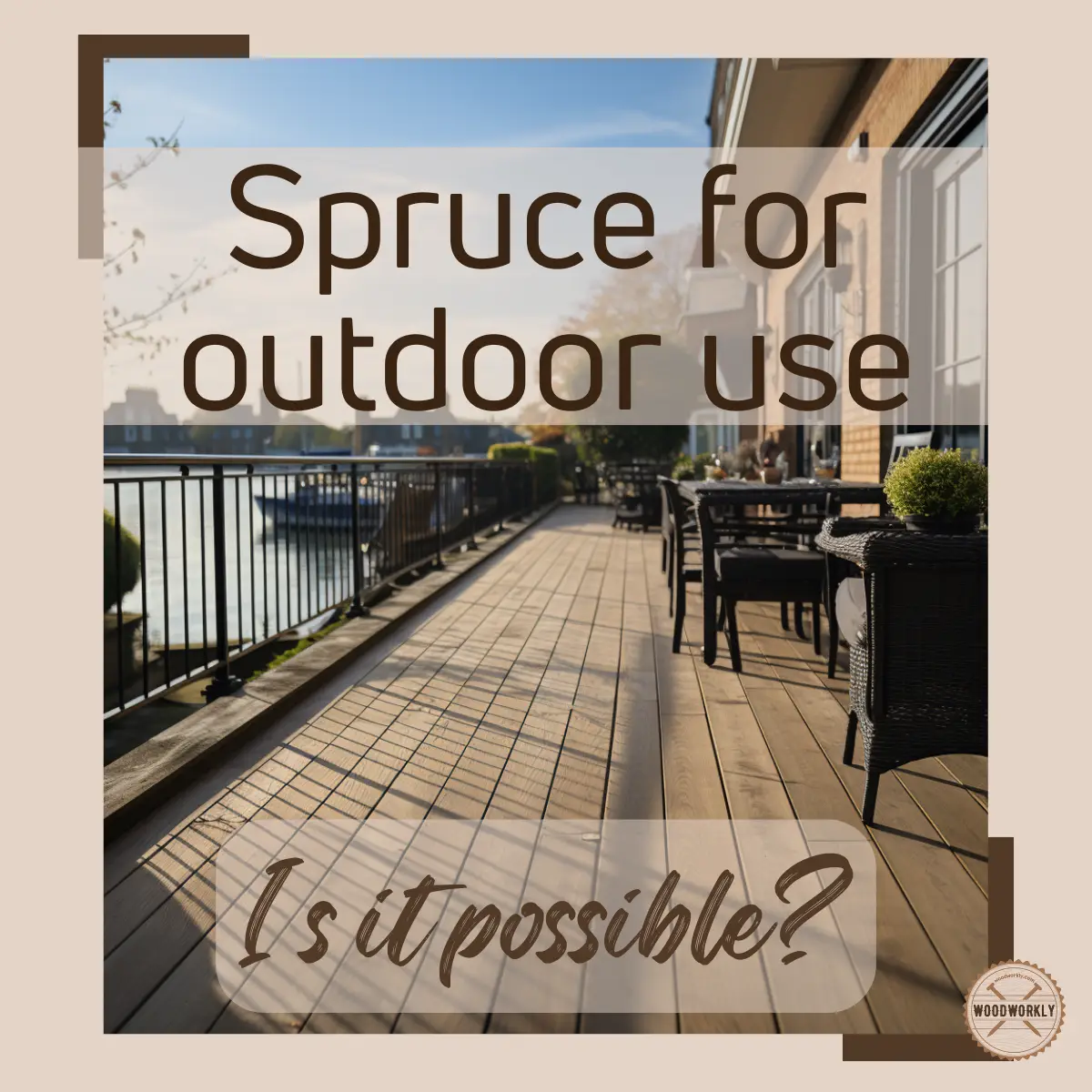
Spruce is a popular softwood known for its excellent strength-to-weight ratio.
Regarding outdoor use, the suitability of Spruce is questionable due to its softwood nature, necessitating consideration of its resistance to environmental impacts.

I conducted thorough research on the use of spruce wood for outdoor projects with the assistance of experts and have learned many aspects that I am now ready to explain.
So, let’s find out, Is Spruce good for outdoor use?
Spruce is not good for outdoor use due to its poor natural resistance to rot, decay, and moisture. However, its suitability can be enhanced with regular maintenance and protective treatments like sealing, staining, or using pressure-treated wood, but it still requires more upkeep compared to naturally resilient woods.
But that’s just a yes or no question since there are some methods you can use for Spruce to use for outdoor use as well.
So, in this article, I’ll explore whether is Spruce good for outdoor use, whether can you use Spruce for the exterior, the advantages, and disadvantages of using Spruce for outdoor use, and how to finish Spruce for outdoor use as well.
Furthermore, I’ll answer some frequently asked questions as well.
Let’s jump in!
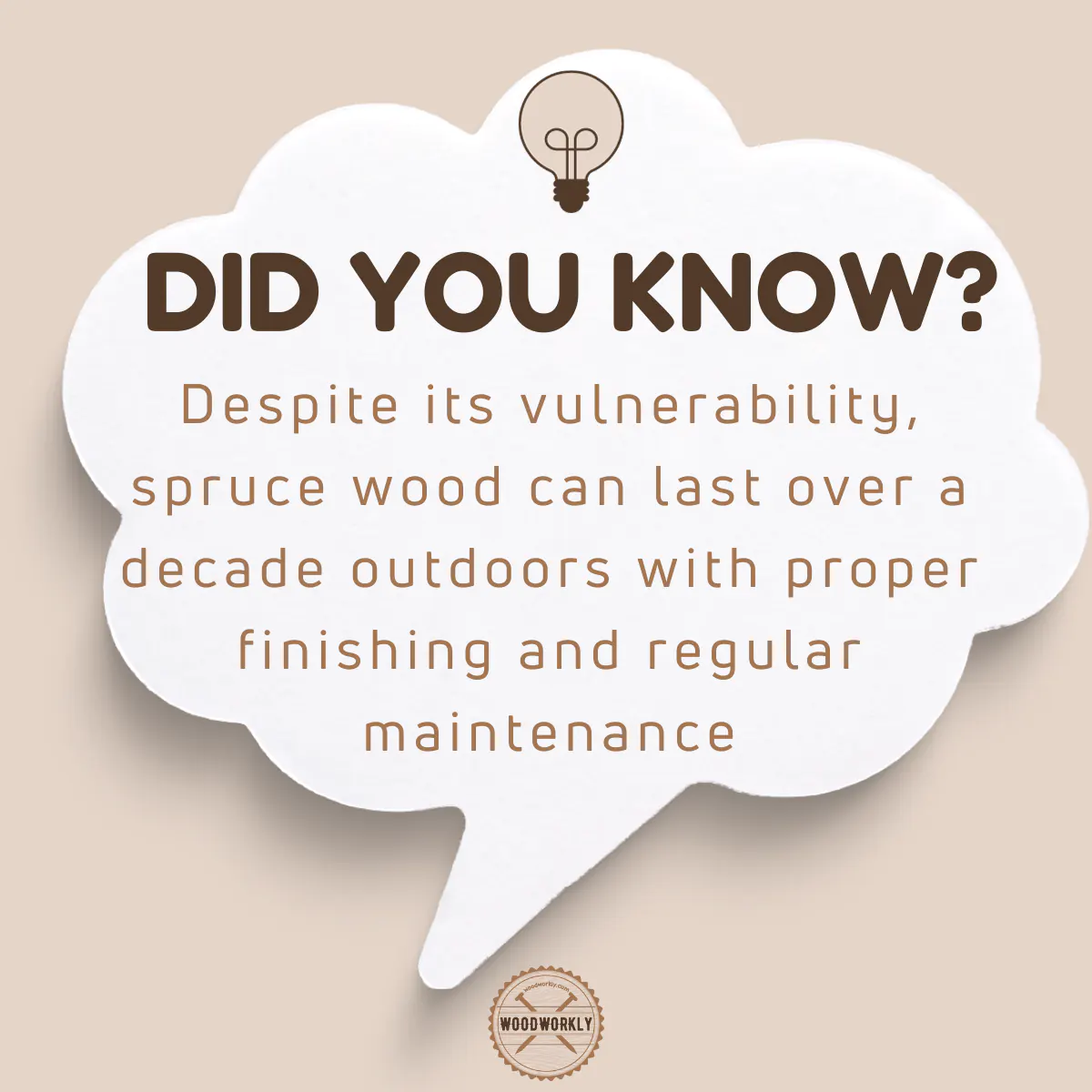
Can You Use Spruce for Exterior?
Yes, you can use spruce for the exterior with proper finishing, but it has poor water resistance and wood tends to rot quickly since it absorbs moisture like a sponge.
You can make Spruce watertight and protected from environmental elements like moisture by sealing it properly.
But overall, Spruce is not good for exterior use.
Plus, Spruce attracts insects and bugs which can cause the growth of mold and mildew.
If you use Spruce as your garden furniture, it will get damaged from moisture and insect attacks.
Spruce wood lacks rot resistance, as even its denser part, the heartwood, only offers moderate protection against rotting.
Plus, Spruce wood may split and crack easily because of its poor weather resistance.
However, wood splitting can be prevented with proper finishing techniques.
To protect Spruce wood from environmental elements, you should apply sealer, stain, paint, varnish, or any other watertight coat over the wood at least once per few months.
Maintaining and refinishing outdoor Spruce wood furniture and woodwork can be so frustrating and a waste of time and money.
If you somehow made a wood finishing or staining mistake, the moisture would penetrate inside of the wood and cause the wood to rot internally.
As you can see, even though Spruce has superior qualities for indoor use, it is not the best choice for exterior applications.
Here are the main reasons why Spruce is not good for outdoor use,
- Poor water resistance
- No rot resistance
- Poor decay resistance
- Susceptible to insect attacks
- Less durability
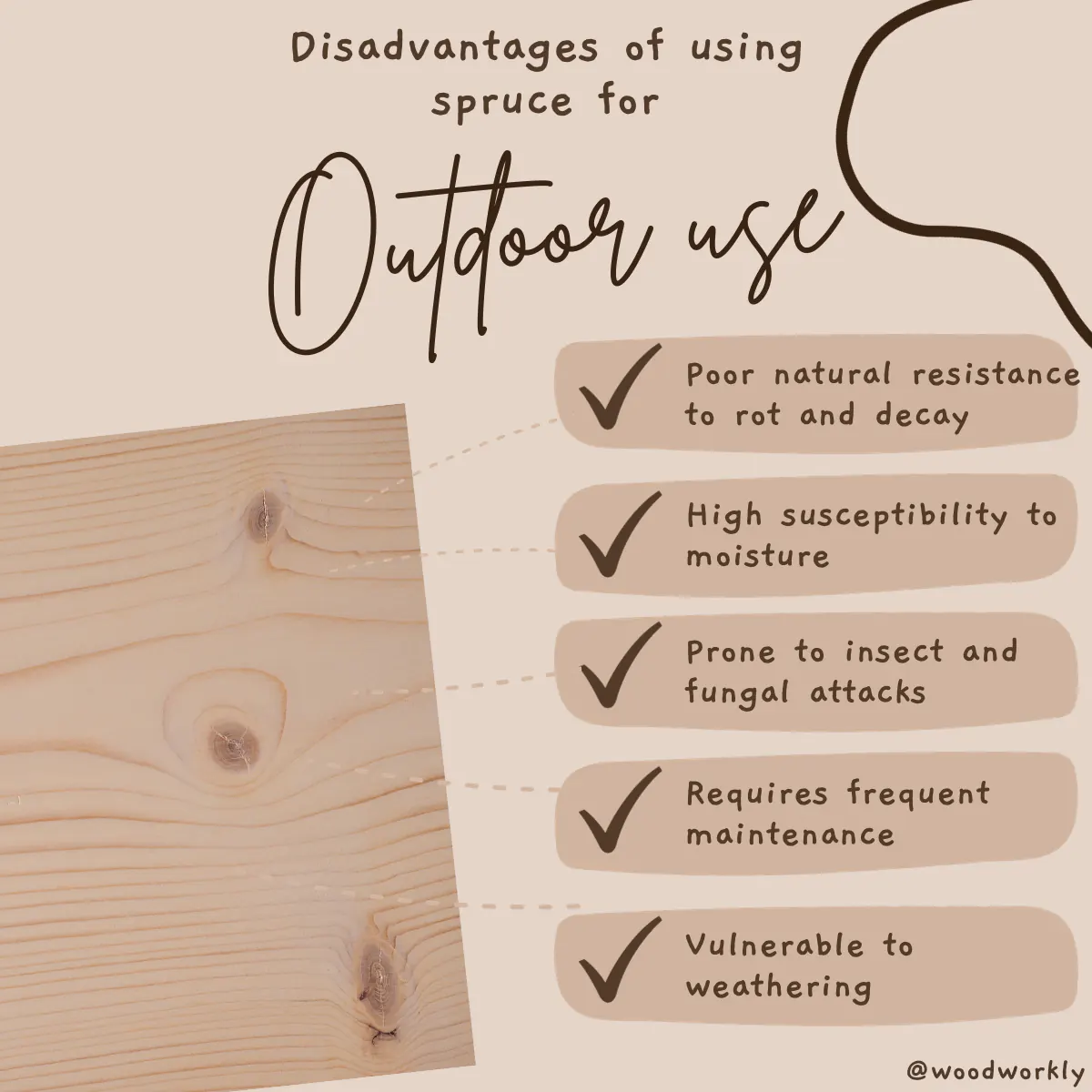
With proper finishing, you’ll be able to seal the outer surface of the Spruce and prevent it from soaking up moisture.
Sealers prevent the wood from absorbing moisture and protect it from environmental elements.
Always use quality sealing and finishing products on Spruce that cause fewer troubles in the future.
Otherwise, Spruce outdoor wood furniture will be ruined after a few months of use.
Anyways, Spruce is a poor choice for outdoor use unless you’re using a proper finishing method.
Advantages and Disadvantages of Spruce For Outdoor Use
Every cloud has a silver lining. Likewise, even though Spruce is not the best wood for outdoor use, there can be some benefits that are useful for outdoor woodworking projects.
| Advantages | Disadvantages |
|---|---|
| Excellent strength-to-weight ratio | Poor weather resistance |
| Lightweight | Less durability |
| Easy to work with | No rot resistance |
| High flexibility | Prone to insect attacks |
| Attractive uniform texture | Poor hardness and density |
| Affordable | |
| Easy to finish and stain |
As you can see Spruce is a wood filled with lots of great qualities that are important for outdoor furniture.
But because of having poor tolerance against environmental impacts, people usually don’t stick with Spruce.
But as you already know most of the environmental impacts can be solved with proper finishing.
So many of the above disadvantages of Spruce can be minimized with excellent finishing and coating.
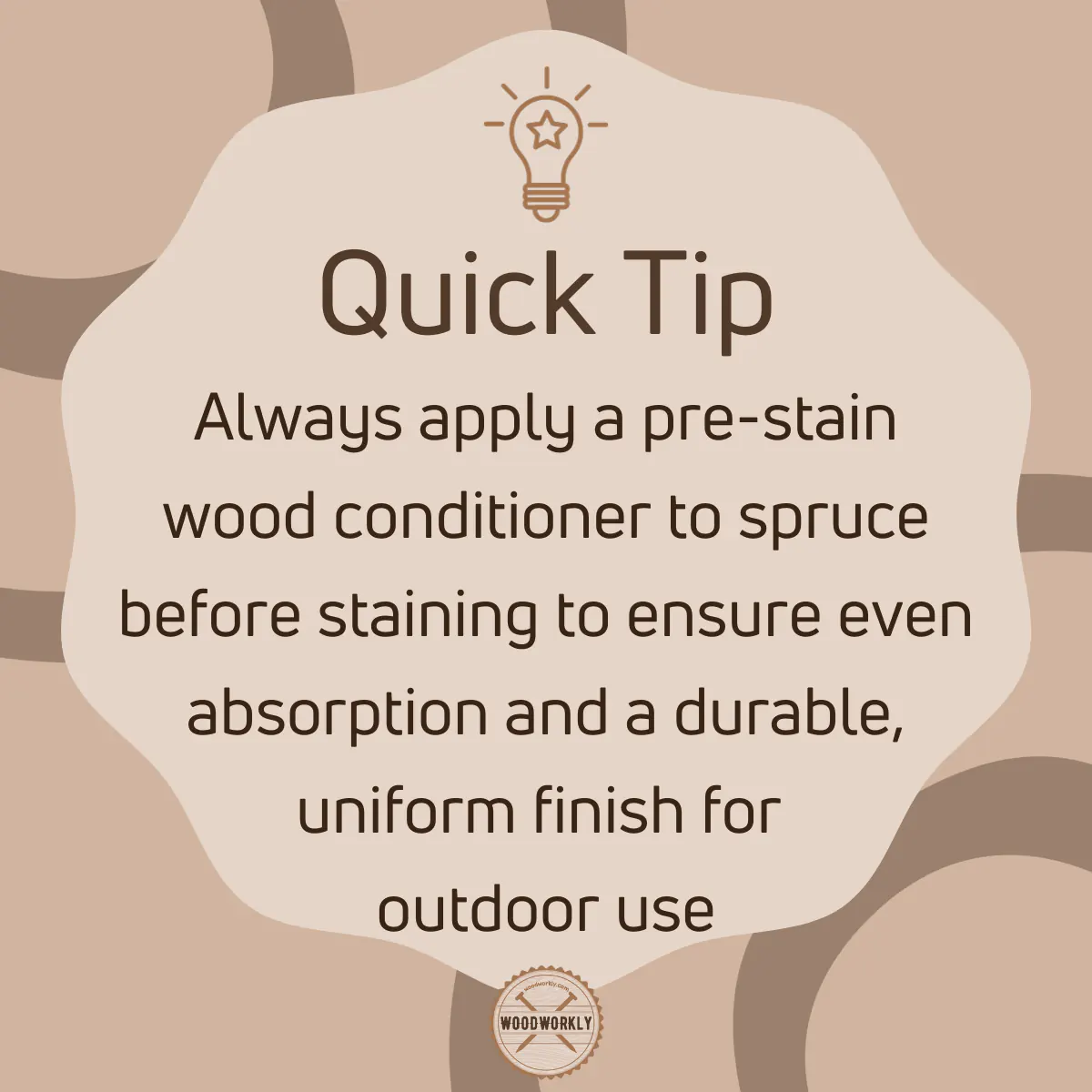
In order to clarify things, let’s find out how to finish Spruce wood for outdoor use.
Supplies You Will Need to Treat Spruce For Outdoor Use
- Wood sealer (polyurethane, varnish, or waterproofing sealer)
- Pre-stain wood conditioner
- Wood stain
- Spruce wood
- Paintbrush
- Rags
- Lint-free soft cloths
- 220 grit sandpaper
Make sure to purchase the above supplies from quality manufacturers to get a quality outcome.
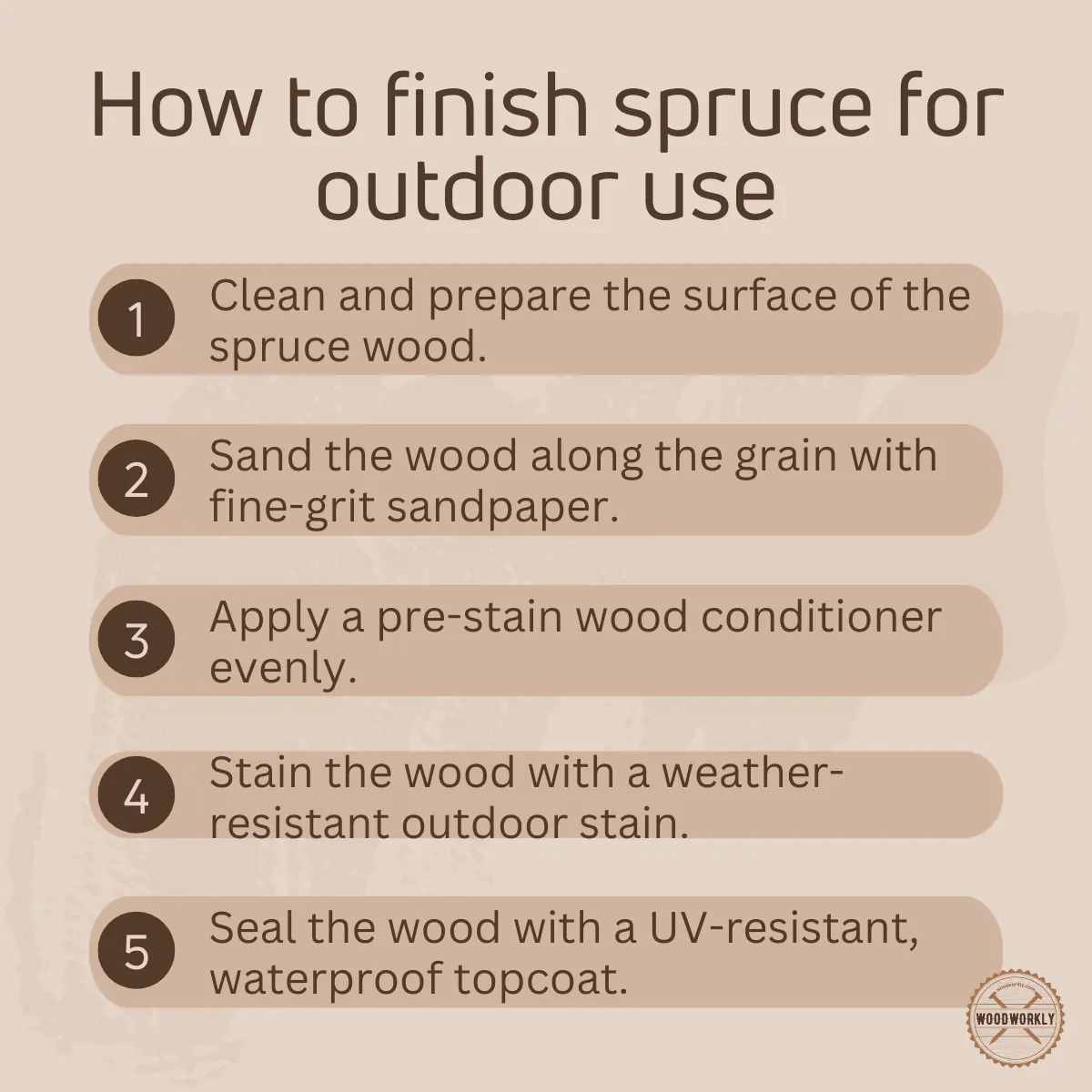
How To Treat Spruce for Outdoor Use?
Spruce wood can stain, seal and finish so well.
waterproofing and UV resistant sealer is the most popular and effective product for Spruce to get protected from environmental elements such as moisture, insect attacks, and UV light.
With proper staining and sealing, Spruce will get an enhanced look and be able to add a unique attractive look to your garden or outdoors.
Proper absorption is a must before placing Spruce furniture outside.
Here is the procedure for treating Spruce for outdoor use,
- Clean the wood and surface preparation
- Sand and remove sawdust
- Apply wood conditioner
- Let it dry
- Apply wood stain
- Let the wood dry completely
- Seal the wood
So, let’s discuss each of the above steps in detail to get a clear idea of finishing Spruce well.
1. Clean and Surface Preparation
Cleaning is the most essential step in wood finishing. If you do the wood finishing without cleaning the surface properly, you’ll face lots of issues like forming bubbles on the coating, blotchy surfaces, cracking, and peeling.
Therefore, proper cleaning is a must before any finishing step.
Take Spruce wood to a well-ventilated area because chemical treatment can cause breathing issues and ventilated areas are helpful to dry the finish quicker.
Take clean rags and dip them in soapy water and wipe through the surface to eliminate dust, dirt, debris, grease, and other residues.
After cleaning the whole surface, let the wood dry completely before moving into the next step.
2. Sand And Remove Sawdust
After cleaning and drying the wood completely, sand the entire Spruce wood surface with 220 grit sandpaper along the direction of the wood grain to eliminate surface randomness and make it super smooth to take on the wood finish so well.
Sanding along the direction of the Spruce wood grain is recommended since Spruce is a hardwood and sanding in the opposite direction of grain may scratch and crack the wood.
Sand the whole Spruce wood surface without missing any spots. End of the day, you’ll get a super smooth and nice surface that is ready to absorb the stain.
Never use high-grade extra coarse sandpapers for this task since they may damage the wooden surface.
Plus, sand with even pressure to avoid getting blotchy or splotchy surface due to surface unevenness.
After sanding the Spruce wood surface properly, remove sawdust using a rag or dust collection pipe.
Never leave sawdust on the surface since they are so hard to remove once it gets stuck with a wood stain.
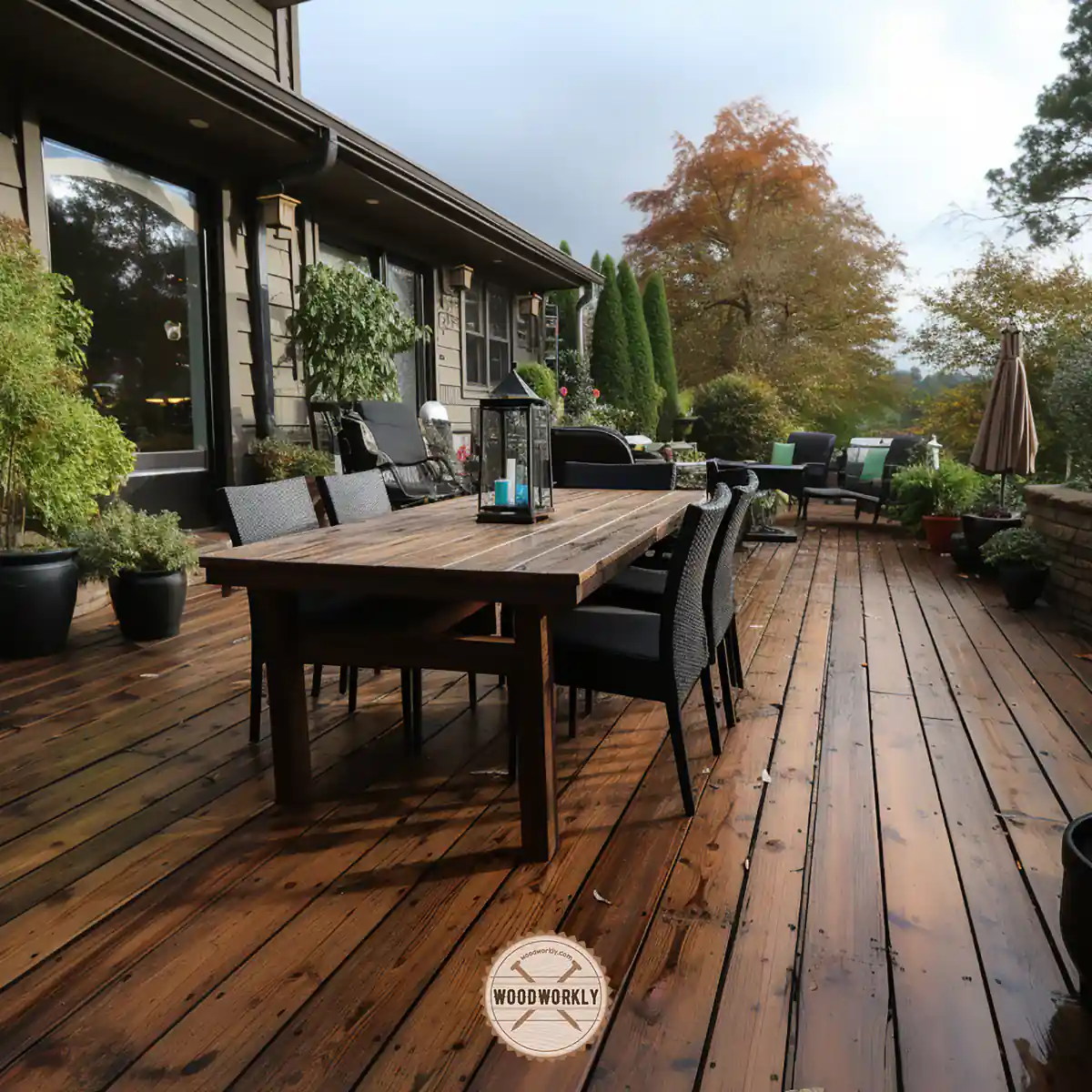
3. Apply Wood Conditioner
Even though Spruce takes stain so well, I highly advise you to use wood conditioner especially since we’re going to prepare indoor favorite wood for outdoor use.
Therefore, the finishing needs to be perfect and wood conditioner helps to finish the wood extremely well.
After cleaning the wood properly. Apply pre-stain wood conditioner all over the surface by dipping a lint-free soft cloth and wiping the entire surface.
Apply wood conditioner along the direction of the wood grain for proper absorption and to minimize slow drying issues.
Generally, Spruce suck up stain like a sponge which is the same as water.
By applying wood conditioner before the stain, the wood conditioner will penetrate through the wood fibers of Spruce and control their absorption rates.
Wood conditioners slow down the absorption speed of Spruce wood and make the whole surface absorb stain amount almost the same.
This helps to apply the stain evenly without making wood stain mistakes like blotches and streaks.
Applying wood conditioner before staining is highly recommended especially if you’re a beginner since it is useful to prevent unnecessary stain absorptions and let a thin coat of stain sit on the surface with proper coating.
Tip:
Better if you could use a wood conditioner from the same manufacturer as a wood stain to avoid incompatibility issues.
4. Let the Wood Dry
After applying the wood conditioner, let it set and dry for at least 45 minutes.
After 45 minutes check the surface whether it has dried completely before moving on to the next step.
Once the wood is completely dry and able to touch with a finger without leaving a smear, you’re good to go for the staining step.
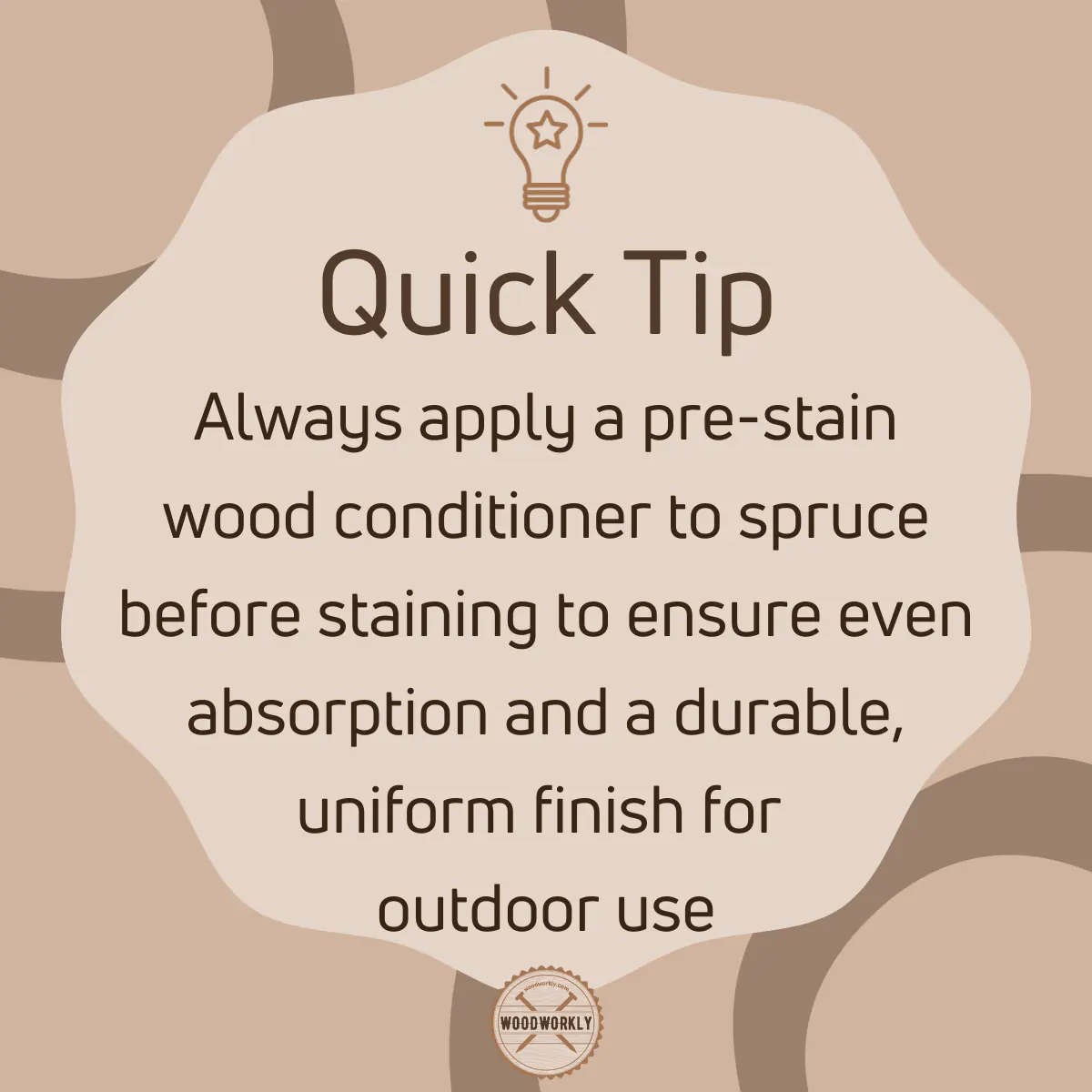
5. Apply Wood Stain
Once the Spruce wood surface is completely dried, dip the paintbrush so the little stain can be and apply the entire wood surface without leaving any spot.
Apply wood stain along the direction of the Spruce wood grain for better absorption and to avoid making bubbles and blotches.
Plus, apply the stain with even pressure on the paintbrush to spread the stain evenly all over the wood.
Apply a thin coat of stain for a highly efficient protective coating and to dry quickly.
Thick coats of stain take so much time to dry and may result in a tacky stain surface at the end that never dries completely.
After applying the stain for 2 -3 minutes wipe off the excess stain on the surface with a rag to get a thin stain coating.
6. Let the Wood Dry Completely
Make sure to let the stain coat dry between coats for around 6 hours for better drying.
Never apply another stain coat before the previous one dried completely to avoid getting a tacky surface.
After applying the final coat of stain, let it dry and cure for about 24 hours to settle on the surface well.
Poor drying causes surface blotchiness, which can be hard to eliminate, and you’ll have to start the finishing process from the beginning.
7. Seal the Wood
Apply waterproofing and UV-resistant sealer once the stain coat is dried completely.
Apply a thin coat of wood sealer along the direction of the wood grain to get nice and even finish.
Once the sealer is completely dried, you’ll begin to see its true color with an enhanced wood appearance.
Therefore, drying is so important to make an excellent coating that helps Spruce wood to get protected from environmental impacts like water damage, insect attacks, UV light, and more.
Now you know how to finish Spruce wood perfectly before placing your Spruce furniture or woodwork outside.
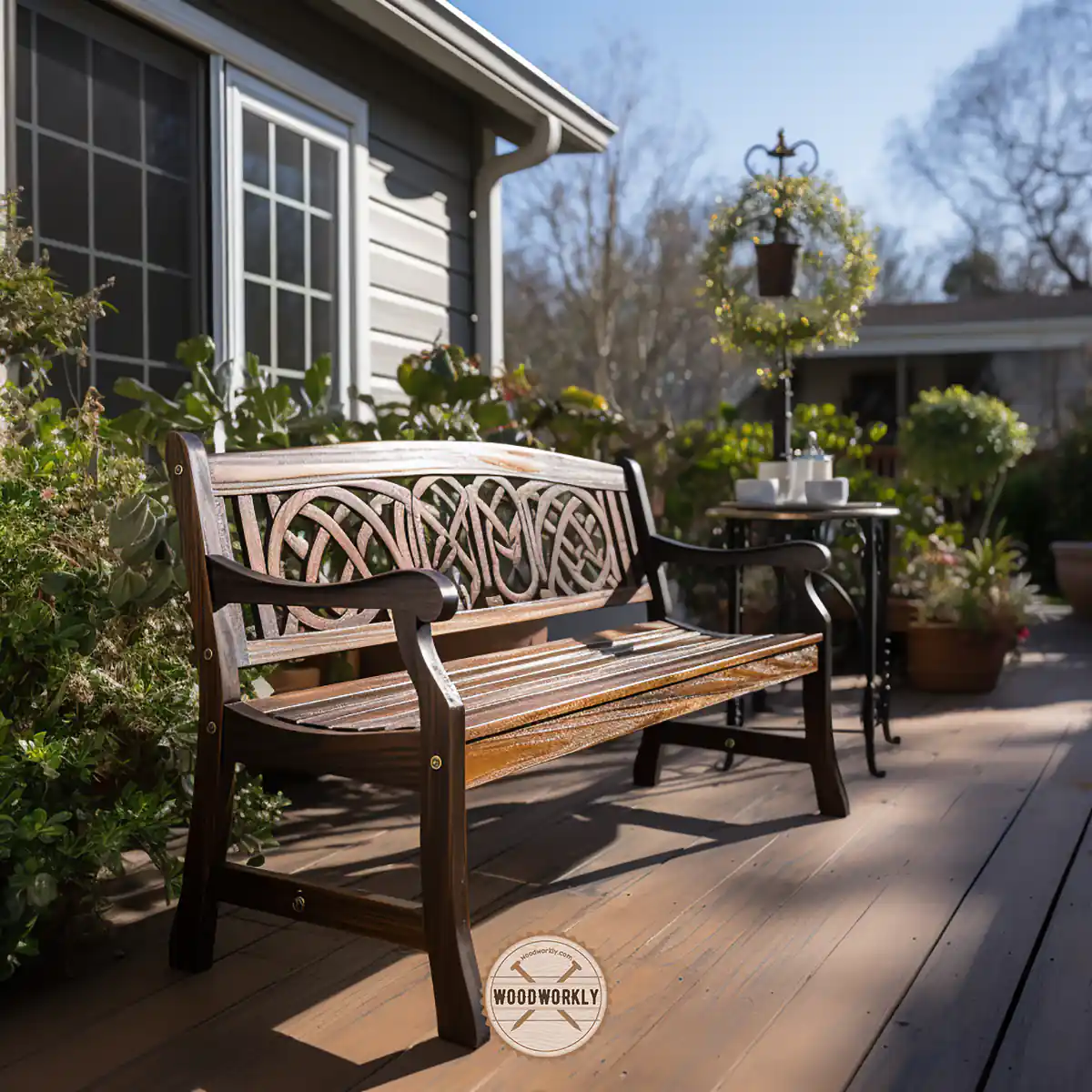
Best Methods to Treat Spruce Wood for Outdoor Use
To enhance the suitability of spruce wood for outdoor applications, it is essential to treat it effectively.
Here are some of the best methods:
- Sealing: Applying a sealant is a fundamental method to protect spruce wood from moisture and environmental elements. Sealants form a barrier on the wood surface, preventing water absorption and reducing the risk of rot and decay.
- Staining: Staining not only enhances the aesthetic appeal of spruce wood but also provides a layer of protection. Stains penetrate the wood, offering protection from UV rays and moisture, and can come in various colors to suit different design preferences.
- Pressure Treating: Pressure-treated spruce wood is infused with chemicals under high pressure, enhancing its resistance to decay, insects, and fungal growth. This treatment is particularly effective for outdoor structures like decks and fences.
- Using Wood Preserver: Wood preservers extend the life of spruce wood by protecting it from fungal decay, insects, and weathering. They can also help maintain the wood’s natural color and strength.
- Applying Wood Oil: Wood oils penetrate deep into the fibers of spruce wood, replenishing its natural oils, enhancing its durability, and offering protection against the elements. Oiling also helps in preserving the wood’s natural look and feel.
- Using Wood Varnish: Varnish creates a hard, protective finish on the surface of spruce wood, making it more resistant to water and weather damage. It is available in various finishes, allowing for aesthetic customization.
- Applying Wood Dye: Wood dyes penetrate the wood to provide a protective layer while maintaining its translucency. They are useful for enhancing the natural beauty and color of spruce wood while offering a range of finishing options.
- Wood Paint: Exterior wood paint not only adds color but also provides excellent protection against peeling, fading, and weather damage. It is suitable for both new and old structures, enhancing the natural color of the wood with pigmented shades.
- Chemical Treatment: Chemical treatments can be applied to enhance the rot and insect resistance of spruce wood. These treatments often involve applying fungicides and insecticides to protect the wood from pests and decay.
Each of these methods has its own set of advantages and can be chosen based on the specific requirements of the outdoor project, the desired aesthetic, and the level of maintenance one is willing to commit to.
It’s important to note that while these treatments can significantly extend the life of spruce wood outdoors, regular maintenance and reapplication of protective coatings will still be necessary to ensure long-term durability.
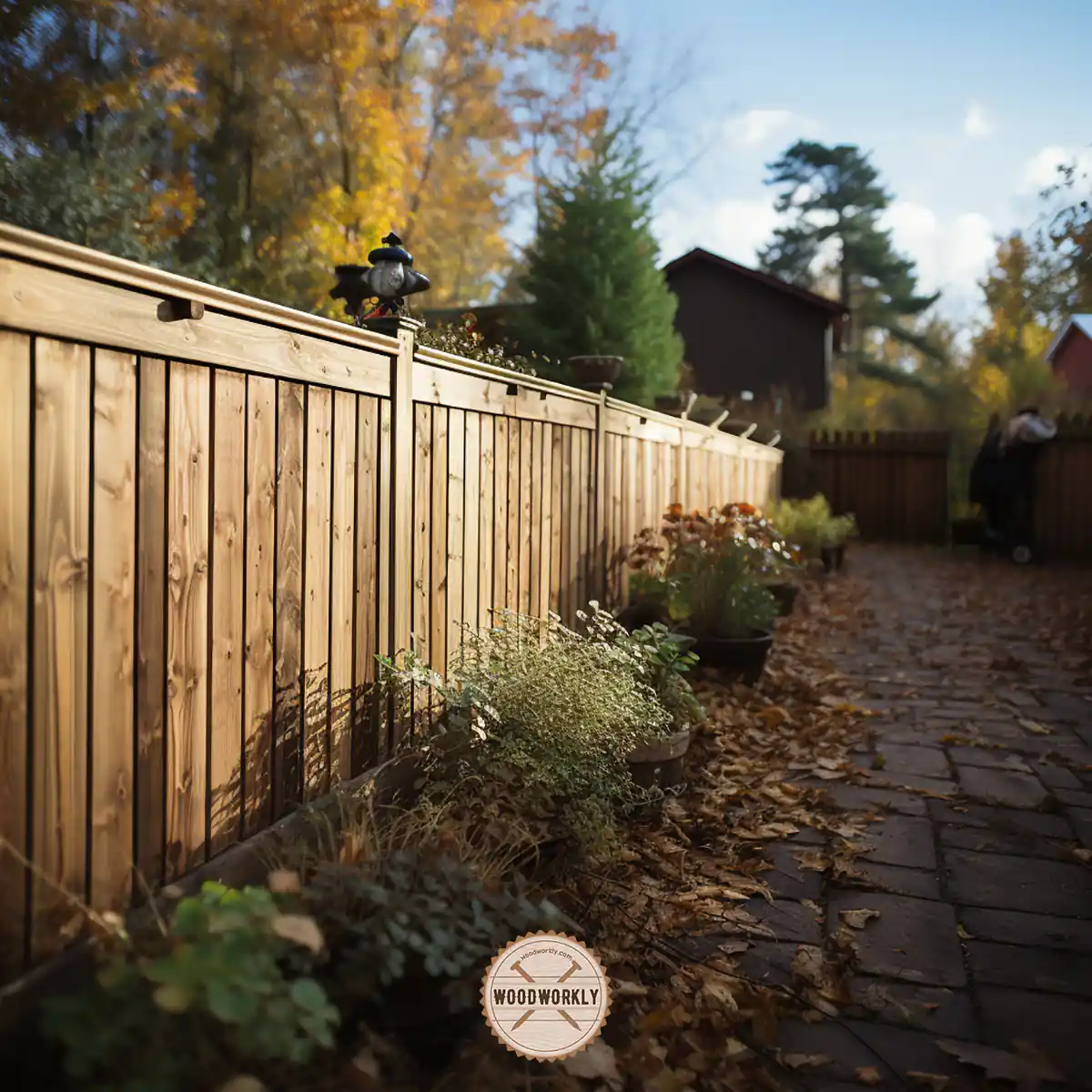
Outdoor Applications of Spruce
- Patio Furniture
- Outdoor flooring
- Outdoor siding
- Exterior paneling
- Wood carvings
- Boxes and crates
- Pallet woods
- Exterior trim
- Framings
As you can see you can use Spruce for lots of outdoor applications by finishing the wood as described above.
Spruce pallet woods need special chemical treatment before being placed outside.
Is Spruce Water Resistant?
Spruce wood, in its natural state, is not highly water-resistant. This characteristic is a critical factor to consider when planning to use spruce in outdoor settings.
Here’s a detailed look into spruce wood’s water resistance:
- Natural Water Resistance: Spruce is a softwood and, like many softwoods, it lacks the natural oils and dense fibers that contribute to high water resistance found in some hardwoods. Consequently, spruce tends to absorb moisture more readily, which can lead to issues like swelling, warping, and rot.
- Impact of Moisture: When exposed to moisture, untreated spruce wood can be prone to damage. The wood fibers absorb water, which can cause the wood to swell and change shape. Over time, repeated cycles of wetting and drying can lead to structural damage, such as cracking and warping.
- Susceptibility to Rot: Spruce wood’s ability to absorb water also makes it more susceptible to rot and decay, especially in damp conditions. This is exacerbated by the fact that spruce does not have significant natural resistance to fungal growth, which thrives in moist environments.
- Vulnerability to Insects: The presence of moisture in spruce wood can also attract insects such as termites and beetles, which are known to cause damage to wooden structures.
- Importance of Treatment: To enhance spruce wood’s water resistance, it is essential to treat it with appropriate sealants, stains, or varnishes. These treatments create a barrier on the wood’s surface, reducing its ability to absorb water and providing protection against moisture-related damage.
- Maintenance for Water Resistance: Even with treatment, spruce wood requires regular maintenance to sustain its water resistance. This involves periodic reapplication of protective coatings and general upkeep to ensure that the wood remains sealed and protected from moisture.
- Comparative Water Resistance: When compared to other types of wood that are naturally more resistant to water, such as cedar, teak, or pressure-treated lumber, spruce is less effective in resisting water damage without proper treatment.

Is Spruce Weather Resistant?
Spruce, widely used in various woodworking projects, presents certain challenges when it comes to weather resistance, particularly in outdoor settings.
Let’s delve into the details of its weather resistance:
- Natural Resistance to Weather Elements: In its natural state, spruce wood does not exhibit high resistance to weather elements. This lack of natural resilience is mainly due to its softwood characteristics, which make it more susceptible to the effects of changing weather conditions.
- Vulnerability to Moisture and Rot: As previously discussed, spruce wood is not highly water-resistant. This makes it particularly vulnerable to prolonged exposure to rain, snow, and humid conditions, leading to potential swelling, warping, and rot.
- Reaction to Sun and Temperature Fluctuations: Continuous exposure to sunlight can cause spruce wood to dry out, leading to cracking and splitting. Additionally, frequent temperature fluctuations can cause expansion and contraction in spruce wood, potentially affecting its structural integrity over time.
- Susceptibility to Insect Damage: Spruce wood, especially when not treated, can attract insects like termites and wood borers. These insects are more likely to infest wood that has been weakened by exposure to adverse weather conditions.
- Importance of Protective Treatments: To improve its weather resistance, spruce wood should be treated with sealants, stains, or paints. These treatments create a protective barrier against moisture, UV rays, and temperature extremes.
- Maintenance Requirements: Regular maintenance, including reapplication of protective coatings and general care, is crucial to sustain the weather resistance of spruce wood in outdoor applications. Without proper maintenance, even treated spruce wood can deteriorate when exposed to harsh weather conditions.
- Comparative Weather Resistance: Compared to more naturally resilient woods like cedar or teak, spruce wood requires more effort to maintain its integrity in outdoor environments. These other woods have natural oils and densities that provide inherent resistance to weather-related damage.
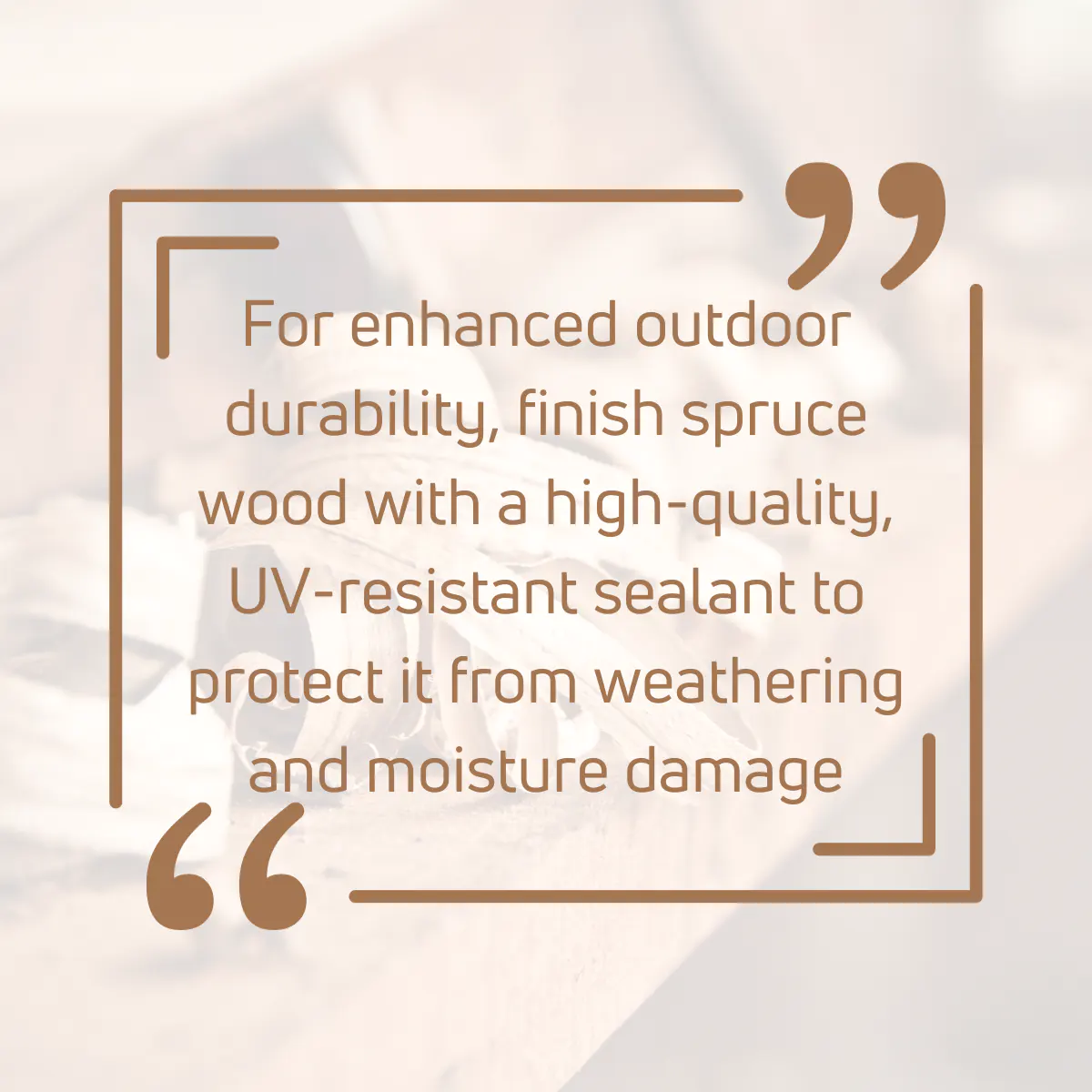
Spruce vs Pine For Outdoor Use
Pine is better than Spruce for outdoor use since pine has great workability. Pine is popular among woodworkers for outdoor use.
Even though both Spruce and pine are softwood pine is popular since once it is treated it is a more useful outdoor wood material than Spruce.
I highly recommend you not to use untreated pine wood for outdoor use since it has poor weather resistance and rot resistance. It is prone to water damage.
Therefore, applying a proper sealer or finisher is a must before using Pine for outdoor use.
For example, Pine is a better choice than Spruce for fence since pine takes paints and stain so well, and finishing pine wood fences are easier than Spruce fences. But Spruce wood is cheaper than pine wood.
Spruce vs Cedar for Outdoor Use
Cedar is generally the better choice for outdoor use than spruce due to its superior natural durability, weather resistance, and low maintenance requirements.
Spruce, while a viable option, requires more maintenance and protection to ensure longevity in outdoor applications.
Here’s a detailed comparison:
- Natural Durability and Resistance:
- Cedar: Cedar is renowned for its natural durability and resistance to rot, decay, and insect infestation. This is largely due to the natural oils present in cedar wood, which provide inherent protection against the elements and pests. Cedar is especially resistant to moisture, making it less likely to warp or swell.
- Spruce: In contrast, spruce lacks these natural oils and therefore does not offer the same level of resistance to rot and insect damage. It is more susceptible to weathering, moisture, and insect-related problems when used outdoors without proper treatment.
- Weather Resistance:
- Cedar: Cedar’s natural oils also contribute to its superior weather resistance. It can withstand various weather conditions, including rain, sun, and snow, without significant deterioration, especially when properly maintained.
- Spruce: Spruce, on the other hand, requires more maintenance to withstand weather conditions. It is prone to weather-related damage such as cracking and splitting, particularly under prolonged exposure to sunlight and fluctuating temperatures.
- Aesthetic Qualities:
- Cedar: Cedar has a distinct, pleasant aroma and a rich, warm color palette that ranges from light amber to deep reddish-brown. Its grain is typically straight and uniform, which, along with its natural coloration, makes it a visually appealing choice for outdoor projects.
- Spruce: Spruce generally has a lighter color, ranging from white to light yellow. The grain pattern is also quite attractive, but it lacks the natural color variety of cedar. However, spruce can be easily stained or painted to enhance its appearance.
- Longevity and Maintenance:
- Cedar: Due to its natural properties, cedar generally requires less maintenance than spruce and can last longer in outdoor environments, even with minimal treatment.
- Spruce: Spruce needs regular maintenance, including treatments with preservatives, sealants, or paints to enhance its durability and weather resistance. Without these treatments, spruce is unlikely to last as long as cedar in outdoor settings.
- Environmental Impact and Sustainability:
- Both woods have considerations regarding sustainability and environmental impact. Cedar, particularly Western Red Cedar, is often praised for its sustainability when responsibly sourced. Spruce, widely used in construction, also has sustainable options, but it’s important to look for certification from organizations like the FSC (Forest Stewardship Council).
- Cost and Availability:
- Cedar is typically more expensive than spruce due to its natural qualities and durability. However, the initial higher cost can be offset by its longevity and lower maintenance requirements.
- Spruce is generally more affordable and widely available, making it a cost-effective option for many projects, but this comes with higher long-term maintenance costs.
- Suitability for Specific Projects:
- Cedar: Its natural resistance to decay and moisture makes cedar ideal for decks, outdoor furniture, siding, and roofing.
- Spruce: While not the first choice for highly exposed outdoor settings, spruce is suitable for structures where it can be adequately protected and maintained, such as in covered patios or outdoor frames.
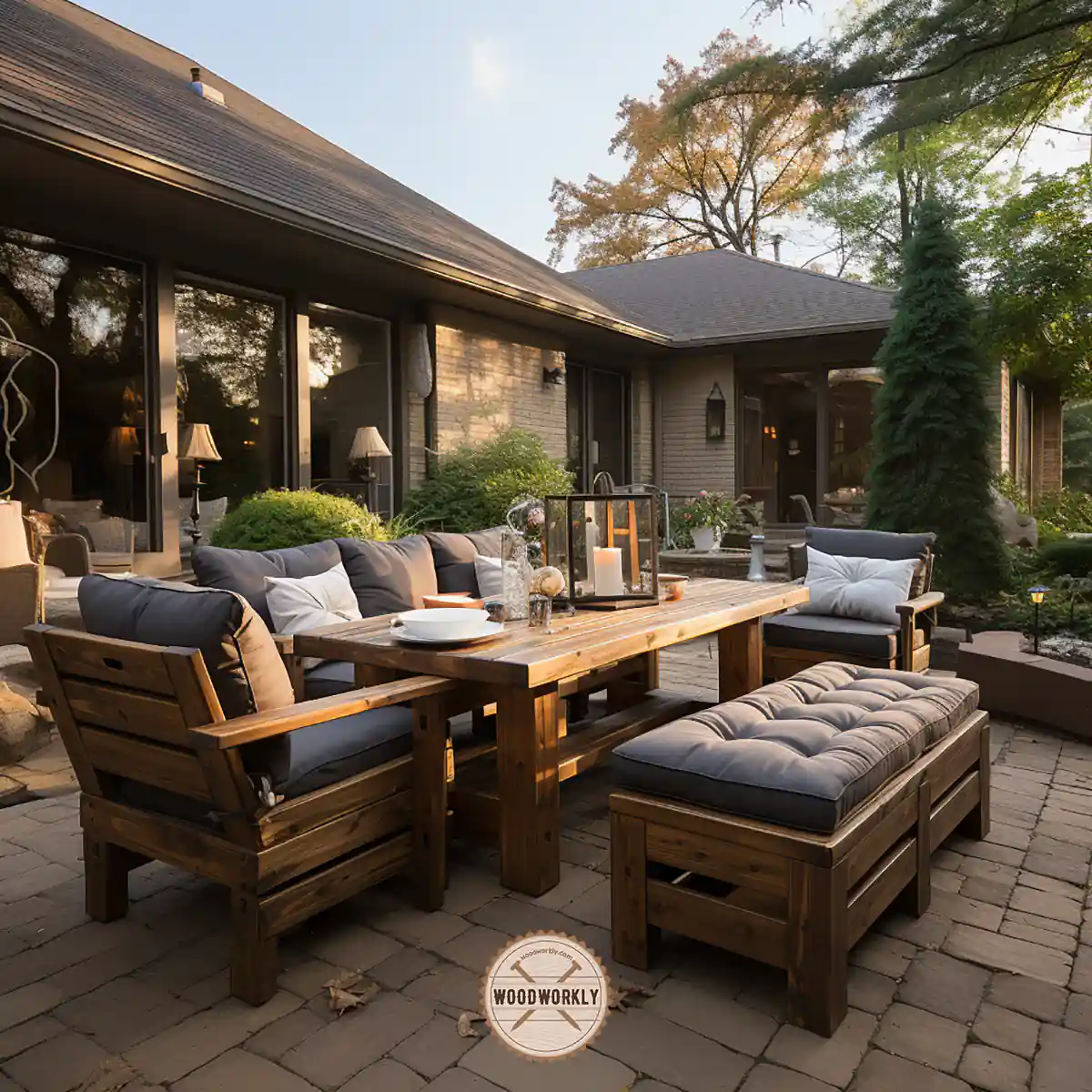
Is Spruce Rot Resistant?
Spruce lumber has no rot resistance. Even the heartwood of Spruce has moderate resistance against rotting, and it gets easily damaged by water, UV light, and insect attacks.
To stop Spruce lumber from rotting, you need to apply a proper finisher or sealant without making any mistakes.
Plus, you can restore rotted Spruce lumber using chemical products like FlexSeal.
How Long Will Spruce Last Outside?
With proper finishing and sealing Spruce can last outside even more than a decade.
But you need to apply a finisher or sealer at least once per year and regular maintenance is a must to protect outdoor Spruce furniture from environmental elements like moisture.
Untreated Spruce wood cannot last for more than 2 – 3 months outside since it gets easily damaged by moisture.
Moisture will penetrate deep inside the wood and cause wood to rot. Bare Spruce wood has no tolerance for environmental impacts.
So, let’s answer some frequently asked questions.
FAQs
Is Spruce Naturally Resistant to Decay and Rot?
Spruce is not naturally resistant to decay and rot, and it requires protective treatments to enhance its durability for outdoor use.
Is Spruce a Cost-Effective Option for Outdoor Projects?
Spruce is a cost-effective option for outdoor projects due to its lower price point, but it may incur higher maintenance costs over time.
How Often Should Spruce Wood Be Treated or Refinished for Outdoor Use?
Spruce wood should be treated or refinished at least once a year to maintain its durability and appearance in outdoor settings.
Does Spruce Wood Require More Maintenance When Used Outdoors Compared to Other Woods?
Yes, spruce wood generally requires more maintenance when used outdoors compared to more naturally durable woods like cedar or teak.
Did I cover all you wanted to know about: Is Spruce Good for Outdoor Use?
In this article, I deeply discussed, whether is Spruce good for outdoor use, why Spruce wood is not recommended for the exterior, its disadvantages, how can we finish Spruce wood for outdoor use, and more.
Spruce is not good for outdoor use since it has poor rot and weather resistance. It has moderate durability. Spruce has no resistance against water damage, and it is prone to insect and fungi attacks. By sealing the wood properly and preventing the wood from touching the ground, it may use for exterior siding.
Furthermore, I’ve answered some frequently asked questions as well.
Hope you have gained good knowledge about whether is Spruce good for outdoor use and related stuff.
Try to finish Spruce wood so well as described above and see how it tolerates environmental impacts.